| Attention Before you read this post, I highly recommend you check out my resources page for access to the tools and services I use to not only maintain my system but also fix all my computer errors, by clicking here! |
Zlib1.dll forms an integral part of the Zlib library build. Its primary function is in the area of data compression. It is free to use, which has gone a long way in popularising it. Zlib1.dll is used on virtually every version of Windows, for general all-round data/file compression. It has and continues to be used on gaming console platforms, such as Xbox, PlayStation and Nintendo. If you’re required to retrieve or store zip files, in your day-to-day computer use, then you should definitely consider Zlib because it’s both highly efficient at its task (compression), and also comes at no extra costs, for the end user.
Still, with the many benefits that comes with the use of this file, it’s not without its faults. It’s frequently known to be the root cause of a number of errors, due to corruption or erasure. Any issues with the zlib1.dll file, could adversely affect your Windows experience, prohibiting it from carrying out specific tasks and functions. Thus, it’s in your best interest to identify the root cause of the problem, so that you can fix it.
In this tutorial, you will find a number of viable solutions for repairing zlib1.dll errors.
Zlib1.dll Overview
Basically Zlib is a highly efficient data/file compression library. Capable of compressing your files/folders without losing any data in the process. It is designed to work on a large assortment of different hardware and operating systems. The data compressed by Zlib, is done with the aid of either the Zlib or Gzip wrapper.
Gzip is essentially a file format that is used in the compression and decompression of files. Zlib is not patented which means it’s accessible to all.
Zlib is designed to be compact and very fast, whereas the Gzip format is designed primarily for the compression of single-files, possessing a significantly larger header than its Zlib counterpart, this allows for much wider directory information maintenance, but a much slower check method. Both the Zlib and Gzip use a compression data format that is similar to much extent, with the only differences being in the trailers and headers around the data that is compressed.
The algorithm Zlib uses to compress its data is known as DEFLATE. Developed by Mark Alder and Jean-loup Gailly. This data compression file format (DEFLATE) was developed using both Huffman and LZ77 coding. The Zlib wrapper utilises the DEFLATE algorithm when compressing data. Incidentally, DEFLATE is also used in .Zip archiving.
Common Zlib1.dll Error Messages
When end users encounter zlib1.dll errors, it’s typically accompanied by an error message. These error messages may vary, but the most common tend to be one of the following:
Zlib1.dll not found.
The file zlib1.dll is missing.
Cannot start Suse Linux 9.2. A required component is missing: zlib1.dll. Please install Suse Linux 9.2 again.
What Causes Zlib1.dll Errors?
When the operating system is unable to locate or read the zlib1.dll file, the various error messages (as highlighted above) will display. These errors may occur because of:
- Improper Windows setting(s).
- Windows registry issues.
- Malware (virus) infections.
In order to fix the problem, you must identify the source of the error. Keeping track of when the error message occurs, will go a long way when attempting to troubleshoot the problem.
How to Fix It
The first thing you’ll want to do, before anything else, is take note of when the error occurs (as previously stated). Does the error occur when attempting to open or use a specific application? If so, then you’ll want to consider reinstalling the culprit program(s). If the error is the result of file corruption, then a reinstallation should rectify the problem, by providing fresh copies of all software files.
Reinstallation is a fairly simple process, the end user need only do the following:
1. First, boot into the system as a full administrator.
2. Then press  + R, type Appwiz.cpl and click on OK.
+ R, type Appwiz.cpl and click on OK.
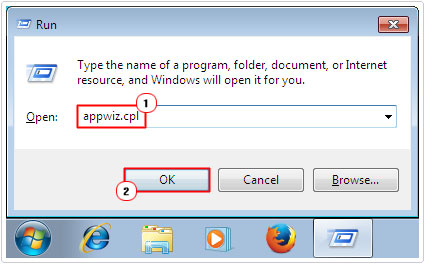
3. When Add or Remove a Programs loads up, simply click on the Application, then click on Uninstall.
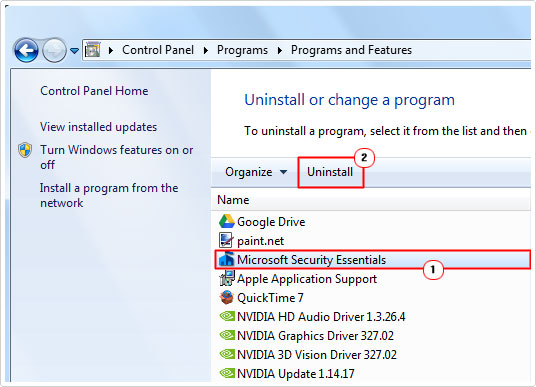
4. Once you have successfully uninstalled the program, you should restart your system, then begin the reinstallation.
Note: The uninstallation is an integral part of the reinstallation phase. If traces of the program are left behind, after removal, the new reinstall could inherit the same attributes, characteristics or settings of the old install. For this reason, it’s important the initial steps be carried out correctly. You can learn more about this particular subject, from my post on uninstall problems.
Run a Registry Scan
One of the quickest and most effective ways of fixing zlib1.dll errors is by repairing the Windows registry. If you don’t know what the registry is, it is essentially a huge database of both software and hardware configuration data.
All key information about the various programs installed on your system, and different hardware components attached to your computer, is stored in the registry. Despite the level of importance attached to the registry, it is highly susceptible to issues. The primarily cause is due to its repeated use, by the operating system. Because the computer is constantly accessing different entries within the registry, sometimes at the same time, it can cause corruption in the event that the system is shutdown abruptly or crashes during general Windows use.
Fortunately, it is possible to tackle issues within the registry, through the use of specialised Windows registry cleaner software, such as Advanced System Repair Pro.
This tool will, scan, detect and repair the registry as well as other key areas of the operating system. You can learn more about this tool, and how it can help you, by clicking on the link below:
CLICK HERE TO CHECK OUT ADVANCED SYSTEM REPAIR PRO
 The solution(s) below are for ADVANCED level computer users. If you are a beginner to intermediate computer user, I highly recommend you use the automated tool(s) above! The solution(s) below are for ADVANCED level computer users. If you are a beginner to intermediate computer user, I highly recommend you use the automated tool(s) above! |
Replace the Zlib1.dll File
Probably one of the best ways, though more complicated ways of fixing errors associated with the zlib1.dll file. Is a fresh copy of the file, and the ability to register it to the Windows registry!
That said, you can find step-by-step instructions on how to do that, from the link below:
1. First, boot into your computer as an administrator.
2. Then download the zlib1.dll file, from one of the following links:
Zlib1.dll for 32-bit Windows: http://www.mediafire.com/file/hab5yvjc4zml8gy/zlib1+32.zip/file
Zlib1.dll for 64-bit Windows: http://www.mediafire.com/file/fmor0t7q3hxgubm/zlib1+64.zip/file
3. The next step is to press  + R, type C:\Windows\System32 and click on OK.
+ R, type C:\Windows\System32 and click on OK.
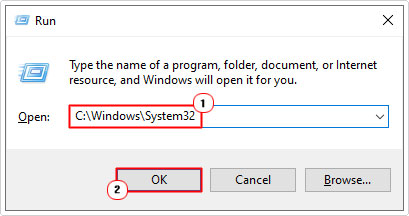
4. When the System32 folder loads up, rename Zlib1.dll to Zlib1BACKUP.dll.
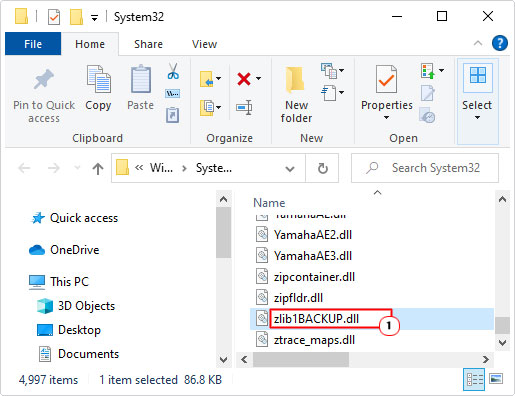
Note: To rename a file, simply right-click on it and select Rename.
5. Now, double click on the Zlib1.zip file, to open it, and select Extract To.
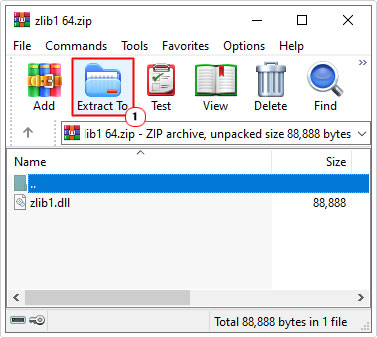
Note: This step may vary, depending on the utility tool you use to open .zip files.
6. When the Extraction path and options applet appears, just type C:\Windows\System32 into the Destination path box and click on OK.
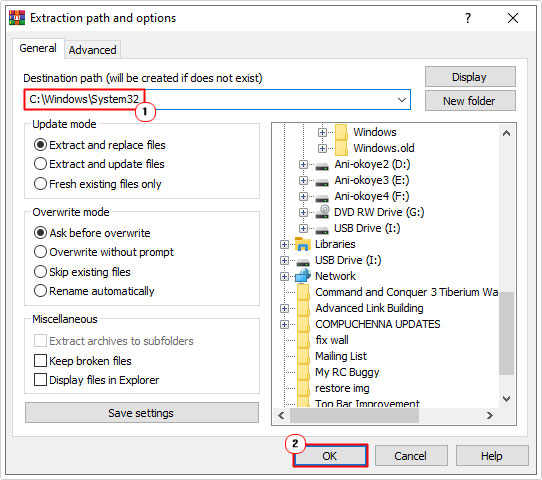
7. Lastly press  + R, type cmd and click on OK.
+ R, type cmd and click on OK.
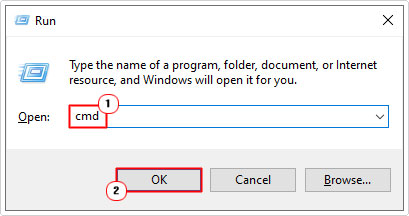
8. From Command Prompt, type the following command below and press Enter.
Regsvr32 zlib1.dll
If carried out successfully, the old zlib1.dll file on your computer, should now have been replaced with a new working version.
Are you looking for a way to repair all the errors on your computer?

If the answer is Yes, then I highly recommend you check out Advanced System Repair Pro.
Which is the leading registry cleaner program online that is able to cure your system from a number of different ailments such as Windows Installer Errors, Runtime Errors, Malicious Software, Spyware, System Freezing, Active Malware, Blue Screen of Death Errors, Rundll Errors, Slow Erratic Computer Performance, ActiveX Errors and much more. Click here to check it out NOW!

